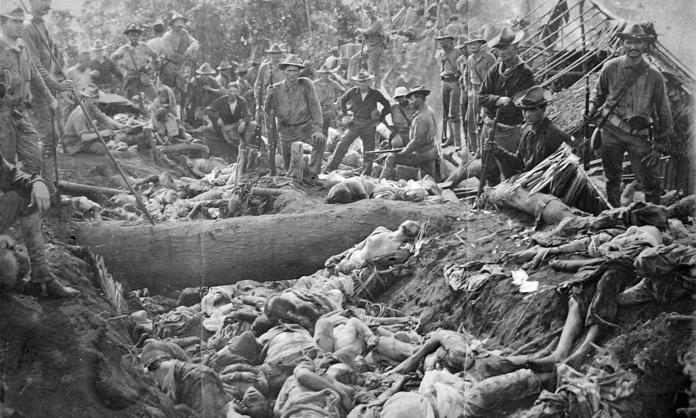When the US secretary of defense, Lloyd Austin, told an audience in Singapore recently that the US would not allow “coercion and bullying” of its allies by China, he must have been counting on a lack of historical knowledge (or a tolerance for hypocrisy) in his audience. Bullying and coercion, including threatened and actual military attacks, are not something new; they have been part of US policy in Asia (and elsewhere) for two centuries.
In the early years of US independence, its capitalists were of course mainly concerned with issues such as European wars, securing westward expansion by expelling or killing Native American peoples, and the developing conflict with the southern slavocracy. But they also never lost sight of the profits to be made from Asian markets and resources, and the danger that their European competitors would get in first and establish “spheres of influence” that excluded US capital. One sign of this was that the US Navy began creating a Pacific Squadron in 1821—almost two decades before official United States territory first reached the Pacific coast.
The Navy’s Pacific Squadron—and its East India Squadron, created in 1835—didn’t have long to wait before being put to use. During Britain’s First Opium War against China, which began in 1839, the East India Squadron intervened on the side of Britain, creating the conditions for the US to impose a commercial treaty on China in 1844. But the biggest plum at the time was Japan.
In the mid-nineteenth century, Japan had been ruled for 250 years by the Tokugawa shogunate, a feudalistic government that brought political stability and considerable economic and cultural progress after a period of civil wars. The shogunate maintained a firm policy of isolation from foreign influences, including trade. The only permitted foreign commerce was conducted through a government monopoly in the single port of Nagasaki. (The reluctance concerning foreign trade was strengthened by the example of British commerce—the opium trade—which had led to the First Opium War.)
US capital, eager to get as much as it could out of the developing exploitation of Asia, sent two US warships that arrived at Edo (Tokyo) Bay in 1846 with a letter requesting the opening of trade between Japan and the US. The request was rejected, so in July 1853, the US sent four warships under Commodore Matthew Perry with a similar letter from the US president.
This time, the Americans refused to accept “no” for an answer. Perry rejected the Japanese instruction to land at Nagasaki and threatened to burn Edo (the Japanese capital) to the ground, at which point the Japanese permitted him to land at a port near Edo. The US warships then proceeded to survey Edo Bay despite Japanese objections. After several displays of US firepower, Perry’s fleet departed, promising to return in a year.
In fact, it returned the following February, now boasting eight warships. Perry made it clear that the fleet wasn’t leaving until a treaty for the “opening” of Japan was signed, which happened at the end of March.
US Navy warships participated in the Second Opium War against China, which ended in 1860 with the US, Britain, France and Russia being granted direct access to Chinese ports and to Peking (Beijing). Citizens of these four powers were also given extraterritoriality regarding Chinese laws.
Even the US Civil War of 1861–65 did little to slow US expansion into Asia. The US bought Alaska from Russia in 1867, gaining a strong presence in north Asia. In 1893, the US seized control of the Hawaiian Islands, providing an important economic and military stepping stone for its interventions in Asia.
US capital faced considerable competition in pillaging the wealth of China. Its intervention largely lagged those of other major powers, such as Britain, which led the way in looting China, as well as France, Germany and Japan. This led US capital to fear that European powers would partition China into separate spheres of influence, excluding the US. In an effort to catch up, the US secretary of state (foreign minister) in 1899 announced the “Open Door policy”. This sought to have US competitors commit to allowing equal access for other countries in their spheres of influence.
That would have contradicted the whole point of a sphere of influence, so the other powers never gave more than lip-service to the policy, but the US continued to cooperate with them when it came to controlling China. Thus the US sent 1,200 marines as part of the international force that suppressed the 1900 Boxer Rebellion.
The US must have thought that sending those marines to China was a generous gesture to its imperialist allies, since at that time it was heavily involved in a much larger war against the Philippines. In the 1890s, to US capital, the remains of the declining Spanish empire looked ripe for the picking, with an ongoing 30-year uprising in Cuba and a growing independence movement in the Philippines. In April 1898, the US declared war on Spain, and on 1 May, a US fleet defeated the Spanish Navy in Manila Bay.
In December, the treaty ending the war gave the US the title to the Philippines. The US was already in control of Manila, but the Philippine independence forces were in control of the rest of the country, and on 12 June they formally declared independence. They had hoped that the US would withdraw once the war with Spain was concluded, but it soon became evident that hope was in vain. On 21 December, the US president issued a proclamation in effect annexing the Philippines.
Years of brutal warfare ensued as the US sought to take control of its new colony. Its overwhelming military superiority allowed the US to defeat the organised Philippine forces, but guerrilla resistance continued until 1906. US anti-insurgency tactics were strikingly similar to those used six decades later in Vietnam. Civilian peasants were forcibly relocated into concentration camps (called “strategic hamlets” in Vietnam), and the surrounding areas were declared free-fire zones.
After a US infantry unit was ambushed with heavy losses on the island of Samar, General Jacob H. Smith ordered a march across the island, commanding his troops to “kill everyone over the age of 10” and to leave the island a “howling wilderness”. An estimated 2,000 to 2,500 civilians were killed.
Letters home from US soldiers often described atrocities they witnessed or participated in, including the widespread use of torture, and some of these accounts were reported in the press. For example, one such letter read:
“The town of Titatia was surrendered to us a few days ago, and two companies occupy the same. Last night one of our boys was found shot and his stomach cut open. Immediately orders were received from General Wheaton to burn the town and kill every native in sight; which was done to a finish. About 1,000 men, women and children were reported killed. I am probably growing hard-hearted, for I am in my glory when I can sight my gun on some dark skin and pull the trigger.”
The US state department estimates that the war “resulted in the death of over 4,200 American and over 20,000 Filipino combatants”, adding that “as many as 200,000 Filipino civilians died from violence, famine, and disease”. The latter figure does not include the estimated 150,000–200,000 deaths from a cholera epidemic at the end of the war.
The US remained the colonial master of the Philippines until evicted by Japanese troops in World War II. In the meantime, it continued trying to ensure its exploitation of China, both by intervening in that country’s civil war and by countering Japanese capitalism’s attempts to conquer large parts of the country.
A US Marine Corps regiment was stationed in Shanghai for more than a decade leading up to World War II, mainly to protect imperialist settlements from troops of the Chinese Communist Party. US aid to the Nationalist forces of Chiang Kai-shek was directed against both the CCP and Japan, and was a factor in the eventual Japanese decision to go to war with the US.
Within days of the Japanese surrender, the US had sent 50,000 soldiers into north-eastern China to ensure that weapons taken in the disarmament of Japanese troops went to Chiang Kai-shek’s forces. But US efforts to secure more of the spoils were badly hampered by a large and mutinous “bring us home” movement that swept through US regiments in both Asia and Europe. The government was forced to spend several years essentially rebuilding its forces before risking another major military intervention.
Its next such Asian deployment occurred in Korea, which had been arbitrarily divided by the US and the Soviet Union to manage the disarming of Japanese troops there. As the Cold War developed, the two zones were hardened into competing autocratic governments, both claiming to be the sole legitimate government of all Korea, which went to war with one another in 1950. The US immediately intervened, in what was supposedly a United Nations operation but in which the US supplied 90 percent of the troops.
In the next three years, US bombers so flattened North Korea that pilots complained they had run out of targets. After US forces approached the border with Manchuria, and China intervened on the side of North Korea, the US Joint Chiefs of Staff drafted orders to drop atomic bombs on air bases in Manchuria and in Shandong province if China used them to launch air strikes against US forces.
Space doesn’t permit, and it is perhaps unnecessary, to detail more recent events—like the long US war against Vietnam (and Laos and Cambodia); Washington’s encouragement and support of Indonesia’s General Suharto, and his regime’s slaughter of a million suspected communists and leftists; and United States backing for the Indonesian invasion of Timor-Leste. (For more on US intervention in China and Taiwan, see my article in the 8 May Red Flag.)
The inescapable conclusion is that neither former president Barack Obama’s “pivot to Asia”, nor the economic warfare against China by presidents Trump and Biden, nor the current preparations for a possible shooting war are in any sense a departure from the long-term US goal of dominating Asia economically and—to the extent necessary to ensure economic domination—politically and militarily. The strategic importance and difficulty of that goal, compared to pursuit of the same goal in Europe, the Middle East or other regions, can of course change with circumstances, requiring “pivots” by Washington administrations. But one thing is certain: US capital will not pivot away from coercion, bullying and open warfare until it is finally defeated.











